All Training Courses
-
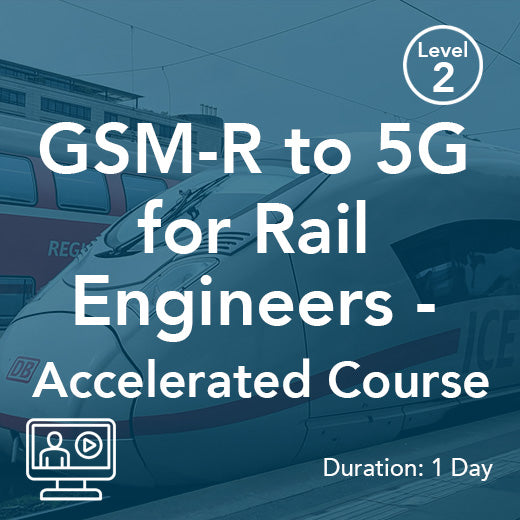
GSM-R to 5G for Rail Engineers – Accelerated Course (On-Demand)
This accelerated one-day course provides rail engineers and technical professionals with a clear understanding of the transition from GSM-R to the Future Railway Mobile Communication System (FRMCS). It explores the fundamental differences in architecture, services, spectrum, and radio technology, highlighting how FRMCS leverages 5G capabilities to deliver enhanced performance, security, and flexibility. Through structured comparisons, participants gain the knowledge needed to appreciate the opportunities and challenges of modernising railway communications and supporting the shift towards the digital railway. This self-paced on-demand distance learning course features illustrated course books, videos, tests and full tutor support. During the course you'll learn: The key technological differences between GSM-R and FRMCS. How network architectures, radio technologies, and addressing schemes compare. The changes in spectrum allocation and radio operation. How 5G technology introduces stronger security and new capabilities for critical railway applications. Who Would Benefit This course is designed for railway engineers, telecom specialists, project managers, and technical administrators who need a clear overview of how FRMCS builds on and differs from GSM-R. It will be particularly valuable for those involved in planning, deploying, or supporting the next generation of railway communication systems, as well as stakeholders who need to understand the operational and technical impacts of the transition to 5G-based FRMCS. Prerequisites A background in GSM-R or GSM would be advantageous. Course Modules Railway Communications Network Architecture Addressing Radio Technology Radio Spectrum Security GSM-R vs FRMCS
£1,336.00
-
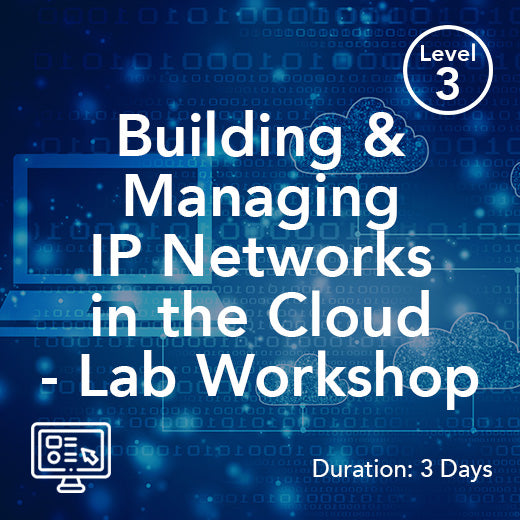
Building and Managing IP Networks in the Cloud - Lab Workshop
This course provides a practical introduction to building and managing IP networks in the cloud. Using Amazon Web Services (AWS) and Infrastructure as Code techniques with Terraform, participants will provision and configure a dedicated lab environment. The course develops skills in IP addressing, subnetting, and routing protocols, applied to Linux-based routers and hosts running on EC2 instances. With a strong focus on hands-on learning, it guides delegates through cloud networking fundamentals, dynamic routing (OSPF, BGP), and troubleshooting end-to-end connectivity. By the end of the workshop, participants will have confidence in deploying, configuring, and testing networking environments in the cloud. Who Would Benefit Network engineers and system administrators seeking practical experience with AWS, EC2, Terraform, and Infrastructure as Code. DevOps and IT professionals who want to build confidence in deploying and troubleshooting cloud-based IP networks. Telecoms operators and engineers aiming to understand how cloud-hosted IP networking and routing protocols can support next-generation telecom systems. Regulators and government agencies who require insight into how cloud environments operate for testing, validation, and compliance. Utilities, transport, and critical communications organisations (e.g. energy, rail, emergency services) modernising their telecoms systems and exploring cloud-based lab and test environments. Enterprise network teams in sectors such as finance, defence, and public safety, looking to integrate cloud networking into their infrastructure planning. Course Contents Cloud, Virtualization, and the Lab Environment IP Addressing and Subnetting IP Networking and Routing Protocols Conclusion & Next Steps Lab Features & Benefits Through a combination of hands-on experience and guided instruction our virtual labs allow users to explore the network. Our labs feature: A simulated network -Provides hands-on experience and reinforces theoretical knowledge. Guided exercises for signalling scenarios - makes learning and applying new concepts straightforward. Cloud-based lab - available 24/7 on any connected device. Individual dedicate server - Ensures that your work is kept private and secure. Ongoing trainer support - ensures you get expert advice when needed. Full integration with Wray Castles training programmes - allows you to build bespoke learning pathways for specialist teams across your organisation.
£2,660.00
-
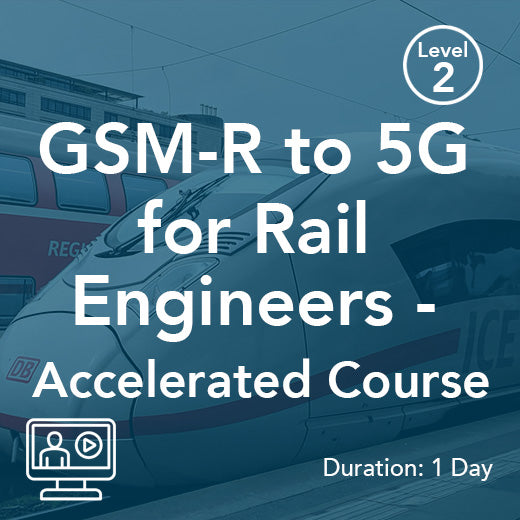
GSM-R to 5G for Rail Engineers – Accelerated Course
This accelerated one-day course provides rail engineers and technical professionals with a clear understanding of the transition from GSM-R to the Future Railway Mobile Communication System (FRMCS). It explores the fundamental differences in architecture, services, spectrum, and radio technology, highlighting how FRMCS leverages 5G capabilities to deliver enhanced performance, security, and flexibility. Through structured comparisons, participants gain the knowledge needed to appreciate the opportunities and challenges of modernising railway communications and supporting the shift towards the digital railway. Who Would Benefit This course is designed for railway engineers, telecom specialists, project managers, and technical administrators who need a clear overview of how FRMCS builds on and differs from GSM-R. It will be particularly valuable for those involved in planning, deploying, or supporting the next generation of railway communication systems, as well as stakeholders who need to understand the operational and technical impacts of the transition to 5G-based FRMCS. Prerequisites A background in GSM-R or GSM would be advantageous. Course Modules Railway Communications Network Architecture Addressing Radio Technology Radio Spectrum Security GSM-R vs FRMCS
£1,336.00
-

Fibre Optic Introduction (On-Demand)
Fibre optics are the foundation of today’s digital networks, enabling everything from high-speed broadband to 5G backhaul and critical infrastructure. This self-paced online course provides a clear introduction to fibre technology, covering both the benefits and the challenges of deployment. You’ll explore the fundamentals of light and optical transmission, fibre structures and cable types, as well as the tools and components used in real networks. Practical topics include splicing, termination, inspection, OTDR testing, troubleshooting, and safety best practices. The course combines expert-written study guides, video tutorials, and regular quizzes to reinforce learning, with certification available through a digital badge awarded for successful completion. With two structured modules – Fibre Optic Networks: Building Blocks and Fibre Optic Networks: Testing and Troubleshooting – this course is ideal for newcomers to fibre optics or professionals seeking a solid technical grounding. Course Contents Fibre Optic Networks: Building Blocks Fundamentals of Light Propagation Fibre Optic Basics Optical Cable Types and Applications Fusion and Mechanical Splicing Optical Connectors and Fibre Termination Passive Optical Components Active Optical Components Fibre Optic Networks Fibre Optic Networks: Testing and Troubleshooting Connector Inspection and Cleaning Optical Power Meter and Light Source Optical Time Domain Reflectometer Optical Network Troubleshooting Safety Best Practices
£2,495.00 £995.00
-

Satellite and Non-Terrestrial Communications in the 5G+ Era
This program explores modern satellite communications and Non-Terrestrial Networks (NTN). It covers key principles, challenges, and technical limitations, including a look at different satellite orbits, as well as HAPS, HIBS, balloons, and drones. The program then explores key use cases and their suitability for satellite and NTN. It surveys existing and emerging proprietary satellite systems and focuses on integrating 5G satellite systems into modern networks. The program also covers different architectures, access technologies (5G New Radio, NB-IoT, and eMTC), and Direct-to-Device (D2D) services. Finally, it explores key challenges and their standardized (3GPP) solutions, such as doppler compensation, latency, and security. Who Would Benefit? This course caters to telecom professionals, engineers, and decision-makers seeking a foundational understanding - ideal for those involved in network planning, technology strategy, and service development. Prerequisites A foundational knowledge of telecommunications would be beneficial. Some familiarity with 5G technology and networking principles will also enhance comprehension. Course Contents Introduction to Satellite Communication Introduction to Non-Terrestrial Networks (NTN) Market and Technology Development 5G Satellite – Deployment and Operational Requirements 5G Satellite Integration and Architectures Key Deployment Challenges and Standardised Solutions
£1,815.00
-

Wray Castle Hub (6 Month Subscription)
6-Month Telecoms Training Subscription Package with Unlimited access to 500+ hours of key training material Empower your professional development by building your knowledge of key technology and business topics within the telecoms industry. Unlimited access to future new courses that will cover the latest technology developments as they are added to Hub throughout your 12-month subscription period. Endlessly flexible and applicable to any role within the telecoms industry a subscription to Wray Castle Hub is your ultimate learning resource. You can choose to follow one of our suggested learning pathways, build your own or dip into the learning material module by module. The Wray Castle Hub is also available as an Annual Subscription for £1,400. Learn more here.
£945.00
-

FRMCS Overview V2 (On-Demand)
This course is aimed at non-technical people or those in management roles that need an introduction to FRMCS. It outlines the need for FRMCS and introduces the standards that are required. The course also discusses the issues with the current radio spectrum allocations and how FRMCS and GSM-R may co-exist in the rollout phase. Also discussed the technology known as 5G that will be an integral part of FRMCS. Now fully updated to include FRMCS V2 specifications Part of UIC Rail Academy Course Contents FRMCS – An Introduction FRMCS Reference Architecture 5G Mission Critical Architecture and Procedures Radio Planning and Migration MCVideo Certified by Institution of Railway Signal Engineers (IRSE) The Institution of Railway Signal Engineers (IRSE) certifies that the syllabus for the FRMCS Overview course is appropriate for meeting the stated objectives of that course. For more information about the scope of the certification process provided by the IRSE please see the IRSE website www.irse.org. Also available as an instructor-led course, learn more
£1,218.00
-
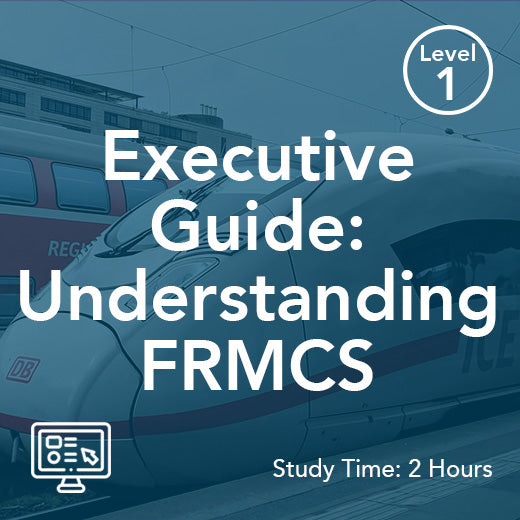
Executive Guide: Understanding FRMCS (On-Demand)
This concise executive briefing provides a high-level overview of the Future Railway Mobile Communication System (FRMCS), the next-generation communication standard for railways, is designed to assist executives seeking to understand the impact and opportunities arising from this new technology. The course explains what FRMCS is, the implication of some of the technical changes on the requirements for physical assets, why it is essential, and the implementation timeline for the migration from GSM-R. Participants will explore the architectural framework, key challenges in deployment, and the business opportunities it presents. Designed for busy executives, this course delivers practical insights in an accessible format.Prerequisites No prior knowledge of FRMCS, GSM-R, or telecommunications is required. This course is designed for those new to the topic, ensuring all acronyms are explained, and foundational concepts are introduced. Who Would Benefit Executives outside of rail companies charged with understanding the business impact or opportunity of FRMCS to their business, for example those already working in the railway ecosystem, those seeking business development opportunities in the rail sector, or those within the telecommunications sector seeking to explore the opportunity offered by FRMCS. Sales professionals preparing for client meetings or presentations involving railway communication systems. Business development / strategy development executives / managers exploring opportunities in the rail and telecom sectors. Policy-makers and regulators overseeing railway digitalisation efforts.Engineers and project managers who need a foundational understanding of FRMCS to support project planning or cross-functional collaboration. Course Contents Introduction GSM-R: The Context Why GSM Needs Replacement Introducing FRMCS FRMCS Challenges Stakeholders and Business Opportunities Timeline rail
£250.00
-

Data Networks – An Overview (On-Demand)
Data networks form the backbone of all modern communication systems. Whether you're working in telecoms, IT, or a related field, a solid understanding of networking fundamentals is essential for navigating today’s connected world. This short, single-module course provides a clear and accessible introduction to how data networks operate, laying the groundwork for further study in networking, internet technologies, or telecommunications. In just three hours, you'll explore the foundational concepts of computer networking, starting with the purpose and structure of data networks and the key terms you need to know. You'll learn about how packet-switching enables efficient data transfer, how the Ethernet protocol supports local area networks, and how the TCP/IP model underpins communication across the internet. The course also introduces you to key internet operations and services, providing insight into how global connectivity is achieved and managed. Whether you're new to networking or seeking a refresher, this course gives you the essential knowledge you need to understand how data moves reliably and efficiently across modern digital systems.Designed for technical professionals and learners with little or no prior experience, this course is the perfect starting point for anyone looking to build confidence in the principles of data networking. Course Contents Background to Computer Networking Packet-Switching Principles The Ethernet Protocol TCP-IP Internet Operations and Services
£95.00
-
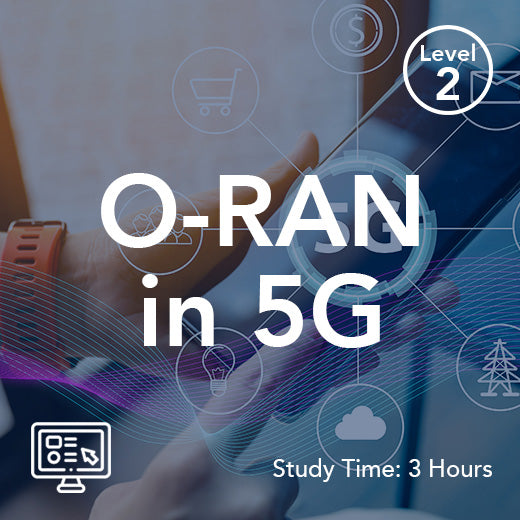
O-RAN in 5G (On-Demand)
As 5G networks become more open, intelligent, and disaggregated, understanding the Open Radio Access Network (O-RAN) is essential for professionals working in mobile network design, deployment, and optimisation. This short, single-module course provides a concise yet comprehensive introduction to O-RAN and its critical role in modern 5G networks. In just three hours, you’ll explore the key architectural and functional components that make O-RAN unique. The course begins with an overview of 3GPP architectural options and how they lay the foundation for NG-RAN deployments. You’ll then examine the principles of RAN functionality and protocols before diving into the detailed architecture of NG-RAN and O-RAN. You’ll gain a solid understanding of functional split options—crucial for enabling multi-vendor interoperability—as well as the differences between traditional and open RAN deployments. The course explains the high-level and logical architectures of O-RAN, including the roles of the Central Unit (CU), Distributed Unit (DU), and Radio Unit (RU), and how open interfaces and intelligent controllers reshape how networks are managed.Additional topics include the application of Artificial Intelligence and Machine Learning in O-RAN, the concept of the O-RAN white box, and critical considerations around fronthaul, backhaul, and interfaces like CPRI and eCPRI. Designed for technical professionals looking for a clear and accessible introduction to O-RAN, this course equips you with the essential knowledge needed to understand the future of radio access networks. Course Contents 3GPP RAN Architecture for 5G 3GPP Architectural Options RAN Functionality and Protocols NG-RAN Architecture Split Options O-RAN, O-RAN Operations and Maintenance High Level O-RAN Architecture Logical Architecture of O-RAN Artificial Intelligence and Machine Learning O-RAN White Box Backhaul CPRI and eCPRI
£95.00 £47.50
-
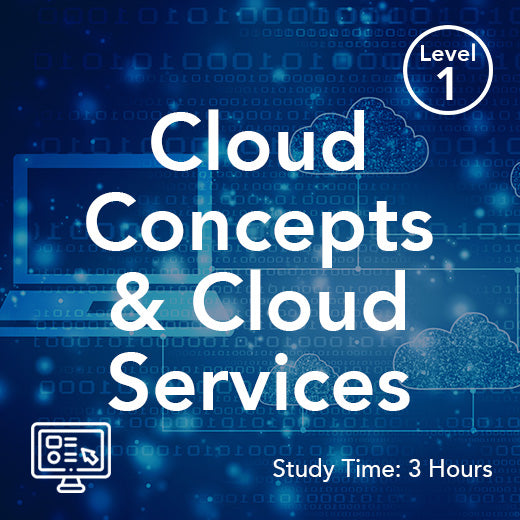
Cloud Concepts and Cloud Services (On-Demand)
Cloud computing has revolutionised how individuals, businesses, and governments access, store, and manage data. Whether you're supporting IT operations, planning digital services, or simply want to better understand this vital part of today’s technology landscape, this short, single-module course introduces the core concepts and services that define the cloud. In just three hours, you’ll start by answering the fundamental question: What is ‘The Cloud’? From there, you’ll explore the most widely used service models—SaaS (Software as a Service), PaaS (Platform as a Service), and IaaS (Infrastructure as a Service)—and how they support different user needs. The course explains how these service models compare, what they enable, and why businesses increasingly rely on them for agility, scalability, and cost-efficiency. You’ll also learn how cloud-based services are used in home and office environments and get an overview of the major cloud service providers and the roles they play in the broader ecosystem. Designed for professionals across telecoms, IT, and business functions, this course provides a practical, jargon-free entry point into the world of cloud services—perfect for anyone needing a clear understanding of cloud concepts without diving into deep technical detail. Course Contents; What is ‘The Cloud’ Types of Cloud Service Cloud Service Models and SaaS PaaS and IaaS Service Models – How Do They Compare Cloud-based Home and Office Services Cloud Service Providers
£95.00 £47.50
-
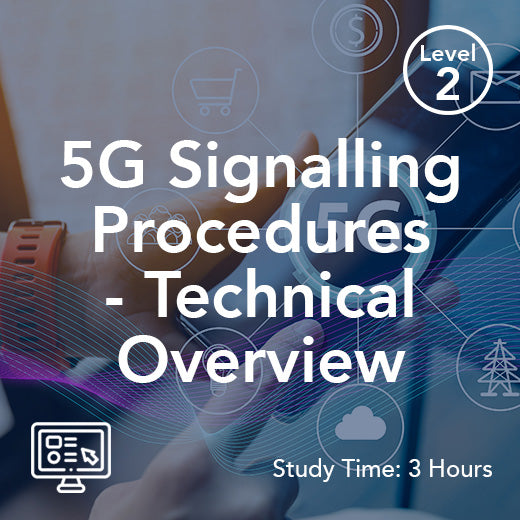
5G Signalling Procedures - Technical Overview (On-Demand)
As 5G networks mature, a solid grasp of the procedures that govern how devices and network functions interact is essential for professionals working in planning, operations, or optimisation. This short course offers a technical overview of the core signalling and operational procedures in 5G Standalone (SA) networks. In just three hours, you'll explore how 5G procedures have evolved - from initial deployments that relied on LTE signalling to fully native 5G implementations across both the core and radio access network. The course covers the step-by-step processes involved in device registration, network function discovery, and session establishment and modification. You'll also gain insight into mobility management procedures, including how 5G handles transitions between different UE states - idle, connected, and inactive - and how it manages tasks like cell selection, registration updates, service requests, and handovers. The role of the Radio Resource Control (RRC) protocol in managing radio connections, reporting measurements, and supporting dual connectivity scenarios is also explained. This course is designed to provide technical professionals with a foundational understanding of how 5G devices and networks interact through signalling and procedure flows, forming the basis for reliable service delivery in real-world deployments. Course Contents 5G Procedures NF Service Registration, Discovery, Subscription and Notification Power-on Procedures Registration Procedure PDU Session Establishment Server-triggered PDU Session Modification and QoS Flow Establishment Change of PDU Session Anchor Mobility Management and Registration Update UE Triggered Service Request Procedure RNA Update and RRC Transitions Xn-based Handover Procedure Addition of a Secondary Node Access Network Release Procedure Signalling Procedures RRC Signalling Overview NSA and SA RRC Reconfiguration Message Overview RRC Measurements Procedures MR-DC Procedures
£95.00
-

5G RAN Architecture and Features (On-Demand)
As 5G networks continue to expand and evolve, a solid understanding of the 5G Radio Access Network (RAN) is essential for those involved in mobile network planning, deployment, or operations. This short, single-module course provides a focused overview of the 5G RAN architecture and the key features that distinguish it from previous generations. In just three hours, you'll explore the structure of the 5G RAN, including the role of the gNB (Next Generation Node B) and its functional split into Centralised Units (CUs) and Distributed Units (DUs). The course explains the key interfaces - NG, Xn, F1, and E1 - that enable communication between RAN components, other base stations, and the core network. You'll also gain insight into different deployment scenarios such as Dual Connectivity (DC) and Multi-RAT Dual Connectivity (MR-DC), which allow 5G to coexist and coordinate with legacy networks. Additionally, the course covers the evolution of the fronthaul interface from CPRI to eCPRI, the importance of backhaul capacity, and the need for precise timing and synchronisation in high-performance 5G networks. Designed for technical professionals needing a clear and accessible introduction to 5G RAN architecture, this course delivers the essential concepts required to understand and engage with today’s 5G radio access technologies. Course Contents 5G RAN Overview Dual Connectivity (DC) 5G non-Standalone and Standalone Options RAN Options EN-DC NGEN-DC and NE-DC RAN User Plane Connectivity RAN Control Plane Connectivity gNB Architecture Centralized and Distributed Deployments Common Public Radio Interface (CPRI) and eCPRI Fronthaul and Backhaul Requirements Synchronisation Requirements
£95.00
-
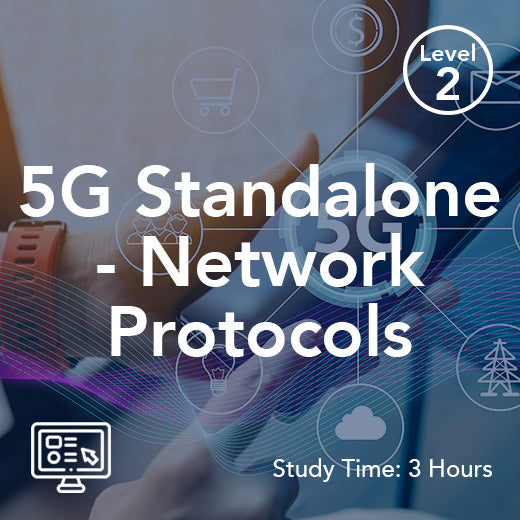
5G Standalone - Network Protocols (On-Demand)
Understanding the protocols that underpin 5G Standalone (SA) deployments is critical for anyone involved in mobile network design, deployment, or troubleshooting. This single-module course provides a practical overview of the key signalling and user plane protocols that enable communication within the 5G system. In just three hours, you'll explore how 5G SA uses modern service-based interfaces, with a focus on HTTP/2 and JSON for communication between core network functions. You'll also learn about protocol roles such as PFCP for user plane control, GTPv2-C for EPC interworking, and NAS protocols for direct signalling with the user equipment. The course also covers the essential signalling protocols in the NG-RAN, including NG-AP, Xn-AP, F1-AP, E1-AP, and RRC - critical for coordinating activity across the RAN and between the RAN and core. On the user plane, you’ll examine how data transport is managed using PDU sessions, and how session types (IP, Ethernet, Unstructured) are established and handled. You’ll also gain an understanding of QoS Flows, with parameters such as 5QI and ARP used to deliver differentiated service levels. This course is ideal for technical professionals who need a working knowledge of 5G SA protocol architecture, signalling behaviour, and data transport mechanisms - without going deep into packet-level analysis. Course Contents PDU Sessions and QoS Flows 5G QoS Parameters, ARP and 5QI Implementation of PDU Sessions IP PDU Session Types, IP Ethernet and Unstructured Multiple PDU Sessions Anchors Reflective QoS User Plane Protocol Stack Core Network Signalling Overview Hypertext Transfer Protocol (HTTP) HTTP 2 and JSON_2 Non-Access Stratum (NAS) and Access Stratum (AS) Protocols Next Generation Radio Access Network (NG-RAN) Signalling Protocols Overview RAN Protocols for the NG, FI, E1 and Xn Interfaces RAN User Plane Protocol
£95.00
-
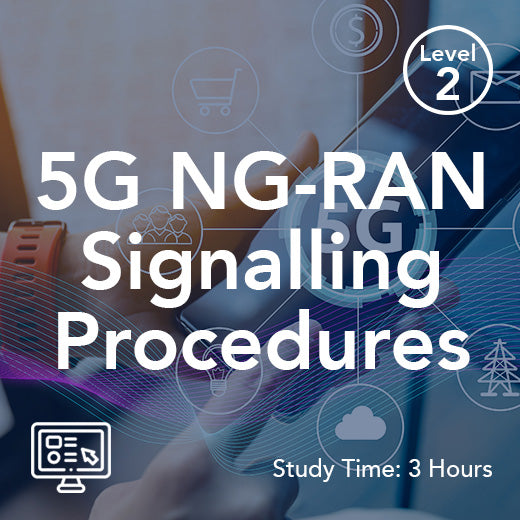
5G NG-RAN Signalling Procedures (On-Demand)
Mobility and state management are at the heart of delivering seamless connectivity in 5G networks. This short, single-module course provides a technical overview of how the 5G Next Generation Radio Access Network (NG-RAN) manages UE mobility and RRC state transitions through signalling interactions. In just three hours, you'll explore how devices move between key RRC states - RRC_IDLE, RRC_INACTIVE, and RRC_CONNECTED - and how signalling flows coordinate these transitions between the UE, gNBs, and core network functions such as the AMF, SMF, and UPF. The course covers a range of mobility procedures, including intra- and inter-gNB handovers, with a focus on signalling, context management, and data forwarding. You'll also learn how dual connectivity is managed, including the addition and release of secondary nodes. Designed for technical professionals who need a solid introduction to how 5G NG-RAN handles mobility and signalling, this course equips you with the essential knowledge required to understand and troubleshoot mobility-related behaviour in live 5G networks. Course Contents Idle Mode RRC Connected Mode RRC Inactive Mode RRC Connected Additional Handovers Secondary Nodes Final Transitions
£95.00
-

5G Standalone - Core Network Architecture (On-Demand)
As mobile networks transition to full 5G Standalone deployments, understanding the 5G Core (5GC) is essential for engineers and technical professionals involved in network design, deployment, or support. This single-module course offers a concise but comprehensive introduction to the 5G Core Network Architecture. In just three hours, you’ll explore the key building blocks of the 5G Core, including the main network functions such as the UDM, AMF, SMF, and UPF, and their roles in managing subscriber data, mobility, sessions, and user traffic. The module also explains important network and UE identifiers, tracking area concepts, and the role of service-based interfaces in enabling 5G’s flexibility. You’ll gain insight into how 5G supports roaming, interworks with legacy EPC networks, and introduces network slicing—a powerful concept that allows the same physical network to support a wide variety of use cases with different performance requirements. This course is ideal for those who need a technical overview of the 5G Core without going deep into protocol-level detail, and serves as a foundation for further learning or practical application in 5G projects. Course Contents 5G Core Network Functions Overview Reference Point Architecture 5G Roaming Architectures Service Based Architecture Service Based Interface Concepts 5G Core Network Functions Data Storage Architecture Interworking and Migration Non-3GPP Access 5G Identities Identities for Network Slicing TAC and RAN Identites
£95.00
-
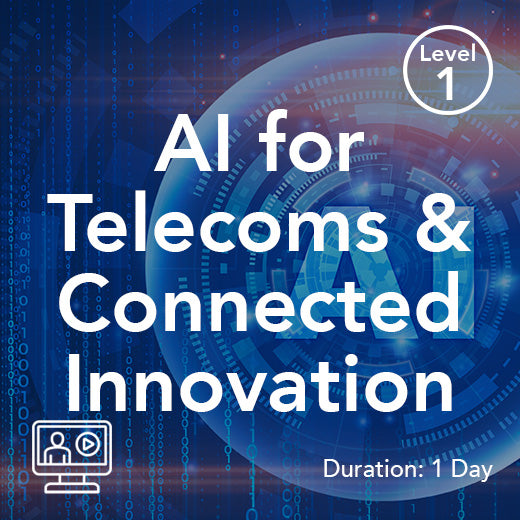
AI for Telecoms and Connected Innovation
Artificial intelligence (AI) is revolutionizing the telecoms industry and driving connected innovation to new heights. This comprehensive course delves into the role of AI in telecoms and explores its various applications, from machine learning to natural language processing, computer vision, and robotics. Participants will acquire a solid understanding of how AI is reshaping telecoms networks to be more efficient and sustainable, as well as its integration into evolving architectures to support cutting-edge use cases like the Metaverse, Intelligent Transportation, and Autonomous Driving. Moreover, the course highlights the synergy between AI and the Internet of Things (IoT), forming the powerful concept of AIoT (Artificial Intelligence of Things). Participants will discover how AI is catalyzing innovation across industries, enabling smarter cities, more efficient manufacturing processes, and personalized healthcare solutions. By the end of the program, participants will be well-versed in AI concepts and techniques, ready to apply their knowledge in telecoms and beyond. Whether pursuing further studies in AI or leveraging their expertise in diverse domains, participants will be equipped to navigate the exciting intersection of AI and telecoms innovation. In a rapidly evolving digital landscape, understanding the fundamentals of AI is essential for professionals in the telecoms industry. This course not only equips participants with practical skills in AI but also instills a deep appreciation for the ethical considerations and responsible implementation of AI technologies. With a focus on real-world applications and industry relevance, this course empowers participants to leverage AI to drive innovation, enhance efficiency, and unlock new possibilities in the dynamic realm of telecoms and connected innovation. Course Contents Introduction to Artificial Intelligence Machine Learning Applying Machine Learning to AI Natural Language Processing (NLP) Computer Vision Robotics and Autonomous Systems AI in Industry AIoT (Artificial Intelligence of Things) Ethics and Responsible AI
£980.00
-
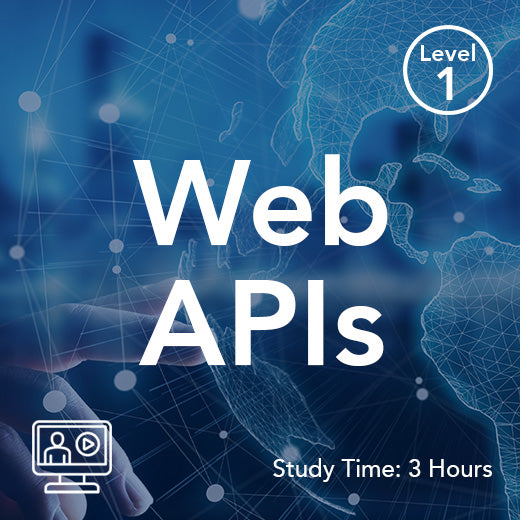
Web APIs (On-Demand)
This course provides a comprehensive and accessible overview of Web APIs - essential tools for enabling communication between modern software systems. It starts with the basics, defining what APIs are and unpacking the components of an API call, before exploring architectural styles including REST, SOAP, GraphQL, and gRPC. You’ll trace the evolution of APIs and gain insight into key protocols such as HTTP/1.1, HTTP/2, and HTTP/3, as well as common data formats like JSON, XML, and YAML. The course also covers important API standards and specifications such as OpenAPI and AsyncAPI, introduces widely used tools like Swagger and Postman, and outlines core security mechanisms including API Keys, OAuth 2.0, JWT, and OIDC. With structured reading content, visual explanations via short videos, quizzes, FAQs, and a final assessment, this course equips you with the foundational knowledge needed to understand and work with Web APIs in real-world applications. Course Contents Introduction to API Web API Core Protocols API Standards and Specifications API Tools API Security
£95.00
-
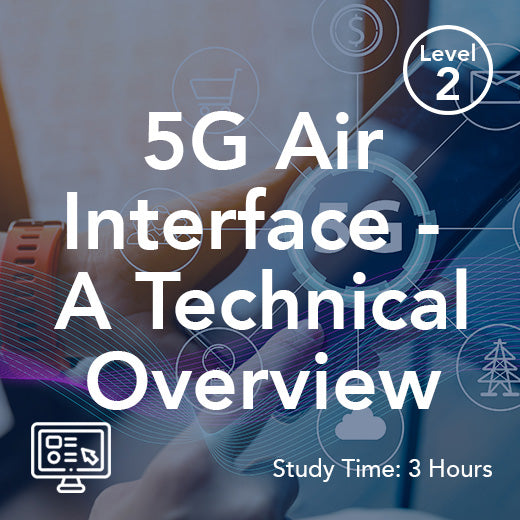
5G Air Interface - Technical Overview (On-Demand)
The 5G New Radio (NR) air interface lies at the heart of 5G’s transformative capabilities, enabling high data rates, low latency, and the flexibility to support a wide range of services - from enhanced mobile broadband to ultra-reliable low-latency communications and massive IoT. Unlike previous generations, 5G NR has been designed from the ground up without the constraint of backward compatibility, freeing it to address the diverse and demanding requirements of next-generation mobile networks. This course offers a technical deep dive into the architecture and operation of the 5G air interface. It explores how key design decisions - such as the adoption of flexible OFDMA, use of millimetre wave frequencies, large-scale antenna arrays, and adaptable subcarrier spacing - combine to deliver major improvements in spectral and energy efficiency. You'll also learn how 5G NR accommodates a wide variety of use cases through its advanced protocol stack, modulation schemes, duplexing methods, and dynamic bandwidth configurations. By the end of the course, participants will understand the principles behind 5G NR’s physical layer, its use of spectrum (including FR1 and FR2 bands), and the challenges and opportunities associated with operating at high radio frequencies. Whether you're a telecom engineer, network architect, or systems analyst, this course provides the foundational knowledge needed to work confidently with the 5G air interface. Course Contents 5G Objective and Performance Requirements Air Interface Protocol Stack Wireless Capacity Growth 5G Spectrum Overview TDD and FDD Overview Millimeter Wave and Antenna Overview mmWave Propagation Characteristics Capacity and Modulation Principles of Orthogonal Frequency Division Multiple Access (OFDMA) Inter-Symbol-Interference Bandwidth Parts Time Domain Structure PHY Resource Grid Physical Channels and Signals
£95.00
-

5G/6G Essential Protocols and Procedures (Training & IEEE Innovation Testbed)
Transformative Training Powered by IEEE and Wray Castle Powered by the joint expertise of IEEE and Wray Castle, the 5G/6G Essential Protocols & Procedures Training and Innovation Testbed offers a comprehensive exploration of 5G’s most crucial protocols and procedures. This cutting-edge course blends robust theory with hands-on practice via the IEEE 5G/6G Innovation Testbed - a secure, cloud-based platform providing end-to-end 5G network testing capabilities. The Key Protocols & Procedures Putting Theory Immediately into Practice 5G Registration Process - Identities, Authentication, Subscriber Data Network Functions & Interactions - UDM, UDR, PCF, AMF, SMF, UPF PDU Session Establishment - End-to-End signaling and network slicing PFCP & N4 Signaling -Policy and Session Management in 5G Specifically designed for: System engineers and integrators Engineers working with operation, optimization, and troubleshooting Technical professionals responsible for 5G System signaling
£1,045.00
-

Introduction to Critical Communications
This introductory course is designed for those who are new to Radio Communications in particular Critical Communications. It is intended for graduates or engineers moving into communications for the first time, non-technical people working in financial control, administrators and those responsible for specifying and tendering for communications equipment. Course Contents Basic Radio Communications Radio Communications Systems Critical Communications Features Narrowband Radio Systems Broadband Radio Systems Spectrum for Mission Critical Networks Standards for Mission Critical Networks 3GPP Defined Mission Critical Networks Network Configuration and Administration
POA: Private Course
-

FRMCS For Mobile Network Operators
Railways worldwide have relied on GSM-R, a specialised adaptation of commercial GSM technology, for critical train-to-controller voice communications and digital signalling for over 15 years. However, GSM-R is reaching the end of its lifecycle and will become obsolete by 2035. The International Union of Railways (UIC) has launched the Future Railway Mobile Communications System (FRMCS) project to design and implement the next-generation communication system. Unlike its predecessor, FRMCS leverages cutting-edge 5G technology and offers mobile network operators (MNOs) a unique opportunity to contribute to this transformative shift in railway communications. This course provides an in-depth overview of FRMCS, highlighting: The transition from GSM-R to FRMCS, including timelines and standards. Planned 5G-based network architecture. Key challenges, such as spectrum allocation, coverage, and capacity. The critical role of MNOs, from infrastructure sharing to delivering broadband services. Tailored for mobile network operators, this course equips participants with the insights needed to engage with the FRMCS initiative, seize new opportunities, and contribute to the success of the next-generation railway communication system.
POA: Private Course
-

TowerCo Master Service Agreements (MSA) (On-Demand)
A concise course on interpreting TowerCo Master Services Agreements, focusing on telecommunications industry contracts. While this course is not a substitute for legal advice, it will empower you to understand and navigate these complex agreements, covering topics from the importance of contracts to verifying agreement accuracy, contract validity, proactive contract management, and an in-depth exploration of typical contract sections. By the end of this course, you'll be equipped to make informed decisions and safeguard your organisation's interests. Course Contents: Contractual fundamentals Jargon buster approach Cellsite outsourcing in context Importance of proactive contract management to avoid costly disputes Generic form of a TowerCo Master Services Agreement Authority Matrixes
£250.00
-
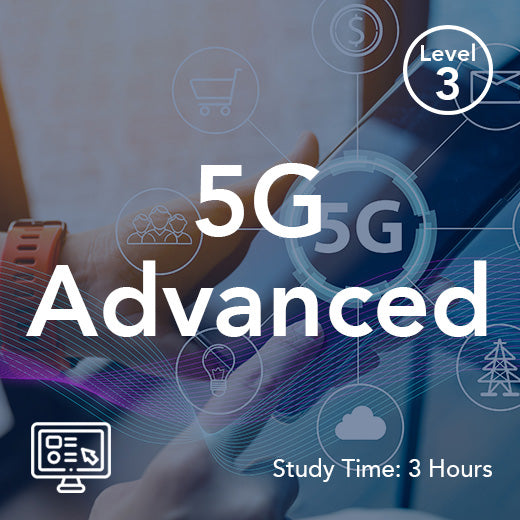
5G Advanced (On-Demand)
5G Advanced On-Demand is a comprehensive course designed to explore the latest advancements in 5G technology, specifically focusing on the enhancements introduced in 3GPP Release 18. This course delves into how 5G Advanced significantly boosts network capabilities, paving the way for future demands and innovations in the telecommunications industry. By understanding the specific features and improvements that 5G Advanced brings to the table, telecom professionals, network engineers, product managers, and individuals involved in strategic planning or technical implementation can stay ahead of the curve and leverage these advancements to drive success in their respective industries. With a concise overview of the enhancements introduced by 5G Advanced, participants will gain valuable insights into how these improvements can revolutionize their current practices and infrastructure. From base capability improvements to specific features unique to 5G Advanced, this course covers a wide range of topics essential for professionals looking to stay informed and competitive in the rapidly evolving telecommunications landscape. Whether you are looking to enhance your technical knowledge or gain a strategic edge in your industry, 5G Advanced On-Demand offers the knowledge and expertise needed to thrive in the era of advanced connectivity and communication technologies. Who Would Benefit This course is ideal for telecom professionals, network engineers, product managers, and anyone involved in strategic planning or technical implementation within telecommunications and related industries who require a concise overview of the improvements 5G Advanced introduces, along with an examination of the specific features and how they enhance their respective industries. Course Contents Introduction 5G Advanced – Base Capability Improvements Specific 5G Advanced Features
£95.00
-

FeMBMS – 4G/5G-based Broadcast (LS telcom)
This training course is aimed at those people working within the wireless communication business or broadcast business. Participants will get an overview on FeMBMS – 4G/5G-based broadcast. The seminar gives an overview on the requirements of broadcast and wireless communication technology and describes how 4G/5G-based broadcast is implemented in the 4G/5G standards. The training is presented in cooperation withRohde & Schwarz. Course Objectives After completing this course, delegates will understand the technology behind FeMBMS – “Further evolved Multimedia Broadcast Multicast Services”. Focus is on the physical layer not on the protocol level. Intended for This course is intended for those who have a basic knowledge in information technology, who may be employed at broadcasters, network operators or regulators. Contents Introduction to „FeMBMS“, 5G/4G-based broadcast Field trials 5G/4G-based broadcast Traditional broadcast DVBIP, IPTV, Streaming, OTT Overview wireless communications from 2G, 3G, 4G to 5G Former mobile broadcast trials and standards, DVB-H/SH, T-DMB, MediaFLO, etc. Traditional Mobile Communication Applications Identification of broadcast applications - for wireless communications “Traditional“ and “Modern“ use-cases in broadcast and in wireless communications Physical layer overview LTE and 5G Single-frequency networks, SFN-requirements FeMBMS – physical layer Comparison to DVB - data rates, robustness, properties, opportunities About LS telcom: LS telcom is a global leader in technologies and consulting services for efficient radio spectrum use, optimizing spectrum management to ensure reliable, interference-free, and secure radio services. Our portfolio includes consulting, measurement services, and integrated solutions for planning, analysis, monitoring, and managing radio infrastructure. Serving customers in over 100 countries, including regulatory authorities, network operators, and industries such as transport, utilities, and security, LS telcom operates globally with subsidiaries and offices in locations like Germany, the UK, Canada, India, and the UAE. Headquartered in Lichtenau, Germany, LS telcom AG has been listed on the German Stock Exchange since 2001 (ISIN DE 0005754402).
£1,650.00
-

DVB-T2 – Measurement Technology in Theory and Practice (LS telcom)
This training course is aimed at those people working within the broadcast industry who have an interest in future development in terrestrial broadcasting. Participants will become familiar with the requirements, new features and consequences of DVB-T2 measurements compared to DVB-T. Beside the general aspects of digital broadcast measurements and measurement parameters the training provides interesting insights inpractical demonstration of field measurements as well as receiver and transmitter tests. The training is presented in cooperation with Rohde & Schwarz. Course Objectives After completing this course, delegates will understand the technology behind DVB-T2 measurements as well as all associated measurement parameters. Several practical demonstrations will solidify the theoretical knowledge. Intended for This course is intended for those who have a basic knowledge of DVB-T2 technology, who are interested in DVB-T2 measurements and who may be employed in broadcasters, network operators or regulators. Contents Basic of digital broadcast measurements (picture quality assessment, transport stream analysis, RF measurements) Basic RF measurement parameters in DTV (level, BER, MER, shoulder attenuation, impulse response) Repetition of DVB-T measurements DVB-T2 measurement technology (i.e. differences to DVB-T, T2-MI analysis, rotated constellations, PLP, SISO/MISO) Practical demonstration of different new T2 features (PLP, rotated constellations, SISO/MISO) DVB-T2 receiver test (theory and practical demonstration) DVB-T2 transmitter test (theory and practical demonstration) DVB-T2 field measurements, SFN measurements (theory and demonstration of a lab SFN) About LS telcom: LS telcom is a global leader in technologies and consulting services for efficient radio spectrum use, optimizing spectrum management to ensure reliable, interference-free, and secure radio services. Our portfolio includes consulting, measurement services, and integrated solutions for planning, analysis, monitoring, and managing radio infrastructure. Serving customers in over 100 countries, including regulatory authorities, network operators, and industries such as transport, utilities, and security, LS telcom operates globally with subsidiaries and offices in locations like Germany, the UK, Canada, India, and the UAE. Headquartered in Lichtenau, Germany, LS telcom AG has been listed on the German Stock Exchange since 2001 (ISIN DE 0005754402).
£1,310.00
-

DVB-T2 – 2nd Generation Digital Video Broadcast (LS telcom)
This training course is aimed at those people working within the broadcast industry who have an interest in future development in terrestrial broadcasting. Participants will become familiar with the requirements, new features and consequences of DVB-T2 compared to DVB-T (such as its higher data capacity) and why it is needed for introducing terrestrial HDTV. Other features such as the possibility of more extended single frequency networks (SFN) will also be discussed. Additional aspects like the current status of DVB-T2 in the world and the compatibility issue between DVB-T2 and LTE complete this training. Finally the course will demonstrate also several practical planning examples using LS telcom’s sophisticated broadcast planning tool. Course Objectives After completing this course, delegates will understand the technology behind DVB-T2, starting with its predecessor DVB-T. The course will also provide participants with basic guidance on planning a DVB-T2 network in respect of satisfying the coverage and capacity requirements including the consideration of possible coordination issues. Intended for This course is intended for those who have a basic knowledge of broadcast technology, who are interested in DVB-T2 and who may be employed in broadcasters, network operators or regulators. Contents DVB-T basics DVB-T2 features DVB-T2 planning/coordination Choice of DVB-T2 parameters Current status of DVB-T2 deployments Compatibility LTE/NR vs. DTT Overview of other DTT technologies including ISDB-T and ATSC Entire terrestrial network planning procedure Alternative terrestrial broadcast distribution platforms like 5G broadcasting About LS telcom: LS telcom is a global leader in technologies and consulting services for efficient radio spectrum use, optimizing spectrum management to ensure reliable, interference-free, and secure radio services. Our portfolio includes consulting, measurement services, and integrated solutions for planning, analysis, monitoring, and managing radio infrastructure. Serving customers in over 100 countries, including regulatory authorities, network operators, and industries such as transport, utilities, and security, LS telcom operates globally with subsidiaries and offices in locations like Germany, the UK, Canada, India, and the UAE. Headquartered in Lichtenau, Germany, LS telcom AG has been listed on the German Stock Exchange since 2001 (ISIN DE 0005754402).
£1,580.00
-

FM, DAB, TV and 5G Broadcast Antennas (LS telcom)
The course is aimed at people working in the broadcast industry who want to get an understanding of the most important topics regarding broadcast antennas. It particularly covers the specifications of antenna components and the layout of broadcast antenna systems for Radio and TV (both analogue and digital) in the VHF and UHF-Band. Additional aspects of the training are methods to design broadcast antenna systems and how to calculate antenna pattern. Finally the training is rounded off by several examples for planning antenna systems for digital terrestrial radio (DAB), digital terrestrial television (DTT) and 5G Broadcast. The course is presented in cooperation with Kathrein Broadcast. Course Objectives After completing the course, participants will have an understanding of the engineering and system design methods of broadcast antennas as well as the technical terms and characteristics. Several practical examples will assist the participants to solidify the theoretical knowledge. Intended for This course is intended for those who have a basic knowledge of radio communication technology, who are interested in broadcast antennas and who may be employed in broadcasters, network operators or regulators. Contents Basics and technical terms of broadcast antennas Antenna radiators and their characteristics Broadcast antenna components and their characteristics Broadcast antenna systems design and pattern calculations methods Examples for planning of antenna systems for Digital Terrestrial Radio (DAB), Digital Terrestrial Television (DTT) and 5G Broadcast About LS telcom: LS telcom is a global leader in technologies and consulting services for efficient radio spectrum use, optimizing spectrum management to ensure reliable, interference-free, and secure radio services. Our portfolio includes consulting, measurement services, and integrated solutions for planning, analysis, monitoring, and managing radio infrastructure. Serving customers in over 100 countries, including regulatory authorities, network operators, and industries such as transport, utilities, and security, LS telcom operates globally with subsidiaries and offices in locations like Germany, the UK, Canada, India, and the UAE. Headquartered in Lichtenau, Germany, LS telcom AG has been listed on the German Stock Exchange since 2001 (ISIN DE 0005754402).
£690.00
-

Measurements of Human Exposure to RF Electromagnetic Fields at 5G NR Base Stations (LS telcom)
The main focus of the workshop is on the measurements and evaluation of high frequency electromagnetic fields generated by 5G Base Stations to ensure compliance with RF exposure safety standards. The workshop is divided in the following blocks. It is mainly aimed at persons regularly working in the field of RF exposure measurement and assessment, e.g. Employees of regulatory and licensing authorities Employees of federal radiation protection authorities, environmental ministries and agencies Occupational safety officers of mobile network operators Personnel of expert offices for the measurement of electromagnetic fields in the context of personal protection. Contents The workshop will focus on the correct determination of the maximum possible radiofrequency fields generated by 5G base stations at the measurement location. In detail, the following topics will be covered: Basics Important differences of 5G systems compared to 4G (LTE) systems. Influence of beamforming antennas on the exposure situation. Challenges for a correct exposure determination at 5G sites with beamforming (mMIMO) antennas. Measurement and Evaluation Measurement of actual 5G field strength level with a spectrum analyzer: Correct setting of the instrument. Possible strategies for the determination of maximum possible exposure. Determination of the maximum RF emission at 5G sites without mMIMO antennas. Determination of the maximum RF emission at 5G sites with mMIMO antennas. Comparison of frequency selective and code selective measurements. Practical demonstration: Code selective measurement of SSS signal. Extrapolation of code-selective measurement results to the situation of maximum radiated power using the antenna patterns of broadcast and traffic beams. Some examples of measurement and extrapolation results at 5G sites. About LS telcom: LS telcom is a global leader in technologies and consulting services for efficient radio spectrum use, optimizing spectrum management to ensure reliable, interference-free, and secure radio services. Our portfolio includes consulting, measurement services, and integrated solutions for planning, analysis, monitoring, and managing radio infrastructure. Serving customers in over 100 countries, including regulatory authorities, network operators, and industries such as transport, utilities, and security, LS telcom operates globally with subsidiaries and offices in locations like Germany, the UK, Canada, India, and the UAE. Headquartered in Lichtenau, Germany, LS telcom AG has been listed on the German Stock Exchange since 2001 (ISIN DE 0005754402).
£810.00
-

Measurements of Human Exposure to RF Electromagnetic Fields (LS telcom)
Radio transmitters produce electromagnetic fields which members of the public may be exposed to. In order to assess people’s safety their exposure must be measured and compared with the appropriate limits. This course will focus on the measurement of general public exposure; in addition, some aspects of occupational exposure are discussed. The lecture will be supported by practical measurements of real-life radio signals by nearby RF transmitters. Course Objectives After completing the training, delegates will be able to perform measurements of RF exposure caused by different radio services which follow the correct measurement methodology, equipment settings and post processing. They will also understand the philosophy behind the exposure limits. Intended for This course is intended for those who have basic knowledge in RF wireless communication techniques and understanding in spectrum analyzer, who are interested in measurement of human exposure to RF electromagnetic fields and who may be employed in regulatory authorities, environmental agencies, radiation protection authorities, health and safety departments of network operators or measurement laboratories. Contents ICNIRP‘s RF exposure limits philosophy Status of current biological research Basic measurement principles Derivation of an appropriate measurement methodology Correct measurements of FM, DAB, DVB-T, GSM, UMTS, LTE, 5G, TETRA, and radar exposures Measurement report and uncertainty budget, typical sources of error Measurement strategies Measurement practice on real-life signals About LS telcom: LS telcom is a global leader in technologies and consulting services for efficient radio spectrum use, optimizing spectrum management to ensure reliable, interference-free, and secure radio services. Our portfolio includes consulting, measurement services, and integrated solutions for planning, analysis, monitoring, and managing radio infrastructure. Serving customers in over 100 countries, including regulatory authorities, network operators, and industries such as transport, utilities, and security, LS telcom operates globally with subsidiaries and offices in locations like Germany, the UK, Canada, India, and the UAE. Headquartered in Lichtenau, Germany, LS telcom AG has been listed on the German Stock Exchange since 2001 (ISIN DE 0005754402).
£2,230.00
-

Practical Spectrum Monitoring Measurements (LS telcom)
This course gives an introduction to practical spectrum monitoring measurements. Delegates will follow practical examples to illustrate the limitations of spectrum monitoring measurements. During hands-on measurements of the RF environment around our Training Academy in Lichtenau/Germany the delegates will put the learned techniques into practice. Course Objectives After completing the training delegates will be able to perform practical spectrum monitoring measurements under real-life conditions and understand the limitations in the RF field. They will also be able to make estimations of expected measurement results, judging the quality of the measurements performed and planning measurementcampaigns. Intended for Regulatory authorities’ staff members supposed to execute spectrum monitoring measurements. Contents Overview of spectrum monitoring tasks Selecting equipment according to the actual task Distinguishing between real signals and intermodulation products Limitations due to the real-life environment Basic measurements Practical measurement on FM broadcast-/DVB-T-transmitters Basic signal analysis Automatic Violation detection Different usage of homing and direction finding Locating transmitters using different methods (AoA/GRoA+/TDOA) Hints and kinks performing measurements Quality of measurement results Planning measurement campaigns Practical hands-on measurements in the field About LS telcom: LS telcom is a global leader in technologies and consulting services for efficient radio spectrum use, optimizing spectrum management to ensure reliable, interference-free, and secure radio services. Our portfolio includes consulting, measurement services, and integrated solutions for planning, analysis, monitoring, and managing radio infrastructure. Serving customers in over 100 countries, including regulatory authorities, network operators, and industries such as transport, utilities, and security, LS telcom operates globally with subsidiaries and offices in locations like Germany, the UK, Canada, India, and the UAE. Headquartered in Lichtenau, Germany, LS telcom AG has been listed on the German Stock Exchange since 2001 (ISIN DE 0005754402).
£2,220.00
-

Spectrum Monitoring - Measurements and Techniques (LS telcom)
This course is based on the latest ITU-R and CEPT recommendations, reports and handbooks and provides an introduction into the most common spectrum monitoring and measurements techniques. It is also presented theoretical background and practical examples that help in understanding specifics of administrative radio monitoring. The training concludes with number of practical examples. Course Objectives After the training, the participants will be able to understand standards, the procedures and methods of the most common monitoring measurements, to distinguish between different measurements technologies, to respect technical limitations of measurement equipment, to present results to different user groups on a simple way. Intended for This course is intended for those who have a basic knowledge of radio communications and electromagnetic wave propagation, who are interested in spectrum monitoring measurement and techniques and who may be employed in regulatory authorities that supposed to execute spectrum monitoring measurements, reporting and providing early warnings to policy makers. Contents General expectations of spectrum monitoring Utilization of radio monitoring results Manual monitoring (ITU/ECC references, proposed procedure) Channel & band occupancy (ITU R1, ERO/ECC) Monitoring of broadcast and digitally modulated signals Interference description, detection, reporting Analysis of results and reporting Automated monitoring Detection of regulatory unauthorized utilizations Inspection/certification/technical acceptance Real time radio occupancy monitoring (for utilizing of whitespace) General license compatibility monitoring (like SRD/ISM/WiFi) Monitoring of assignments (like cellular access systems or MMDS) Areal monitoring (geolocation of low power sources) Interpretation of results and publishing (what, why and when to publish) About LS telcom: LS telcom is a global leader in technologies and consulting services for efficient radio spectrum use, optimizing spectrum management to ensure reliable, interference-free, and secure radio services. Our portfolio includes consulting, measurement services, and integrated solutions for planning, analysis, monitoring, and managing radio infrastructure. Serving customers in over 100 countries, including regulatory authorities, network operators, and industries such as transport, utilities, and security, LS telcom operates globally with subsidiaries and offices in locations like Germany, the UK, Canada, India, and the UAE. Headquartered in Lichtenau, Germany, LS telcom AG has been listed on the German Stock Exchange since 2001 (ISIN DE 0005754402).
£1,300.00
-

LS OBSERVER – Sensor-based Monitoring and Direction Finding (LS telcom)
The LS OBSERVER system training introduces the features of the LS OBSERVER based monitoring units and the principles of operation as sensor-based systems. The course contains the detailed description of the operation of all features and allows the participants to perform practical tasks with the LS OBSERVER system. The service-oriented system configuration and architecture, the remote control of measurement units, the measurement data download, multiple geolocation methods, the analysis of measurement results and direction finding techniques will be presented. The participants will have the possibility to use the equipment for practical tasks during the training. Information about maintenance requirements and configuration of the system are also covered by the training. Course Objectives The training enables the participants to become familiar with the LS OBSERVER monitoring units and the associated software module LS OBSERVER CMS. They will understand the functionalities, handling the GUI and learn how to perform measurements and analysis with the focus on remote controlled monitoring, geolocation and direction finding. Finally, they will see how a fully integrated spectrum management (e.g. SPECTRAplus) and monitoring system can be managed and be used for combined tasks (e.g. automatic violation detection). Intended for This course is intended for monitoring personal who have a basic knowledge of radio monitoring and geolocation methods and who need to operate LS OBSERVER units for measurement, direction finding and analysis tasks. Contents Global overview of the LS OBSERVER service-oriented architecture Typical system and network setup and configuration GUI concept and handling Wide-band measurements Fixed frequency measurements Recording of the measurement results Direction Finding AoA measurements Geolocation with TDoA and GROA+® DF Time Travel® AoA combination of TDoA, GROA+® and AoA results Data handling, download from remote monitoring units About LS telcom: LS telcom is a global leader in technologies and consulting services for efficient radio spectrum use, optimizing spectrum management to ensure reliable, interference-free, and secure radio services. Our portfolio includes consulting, measurement services, and integrated solutions for planning, analysis, monitoring, and managing radio infrastructure. Serving customers in over 100 countries, including regulatory authorities, network operators, and industries such as transport, utilities, and security, LS telcom operates globally with subsidiaries and offices in locations like Germany, the UK, Canada, India, and the UAE. Headquartered in Lichtenau, Germany, LS telcom AG has been listed on the German Stock Exchange since 2001 (ISIN DE 0005754402).
£2,600.00
-

Technical Issues in Radio Spectrum Management (LS telcom)
At its heart, radio spectrum management is essentially a technical discipline, overlaid by strategic and economic considerations. One of the main technical goals of spectrum management is to control interference between radio users so as to optimize the use of the spectrum. Controlling interference is not straightforward and requires the balancing of many factors and undertaking this balancing act requires expert skills. This course describes the necessary theoretical, practical and physical qualities of the radio spectrum including the specifics of wave propagation. Following a review of technical fundamentals such as modulation, antennas and propagation modeling, the course considers the characteristics of different parts of the radio spectrum, and examines in detail the different uses to which it is put. The course then discusses why specific uses are often associated with particular radio frequencies and reviews the technical capabilities and limitations of today’s RF technologies. Interference mechanisms and coordination procedures are explored, together with an understanding of how the performance of radio equipment affects interference and coverage. Finally, detailed explanations of the specifics of the most common radio communication services including broadcast, land mobile, fixed and satellite services are given. Course Objectives After completing the course, participants will have a full understanding of the technical and physical issues which impact spectrum management. In addition, they will have deepened their technical knowledge of different radio services and will understand the principles behind controlling interference and the coordination procedures. Intended for This course is intended for those interested in the technical aspects of spectrum management. This includes those working in a technical function at regulators as well as in telecommunications and broadcasting companies and in organizations with a need for strong technical knowledge. Contents Communication principles, modulation techniques and antennas Radio wave propagation, terrain data and propagation calculations Characteristics and use of the radio spectrum from ELF to EHF Detailed exploration of a range of radio communication services: Technical characteristics, service planning Frequency assignment, coordination procedures About LS telcom: LS telcom is a global leader in technologies and consulting services for efficient radio spectrum use, optimizing spectrum management to ensure reliable, interference-free, and secure radio services. Our portfolio includes consulting, measurement services, and integrated solutions for planning, analysis, monitoring, and managing radio infrastructure. Serving customers in over 100 countries, including regulatory authorities, network operators, and industries such as transport, utilities, and security, LS telcom operates globally with subsidiaries and offices in locations like Germany, the UK, Canada, India, and the UAE. Headquartered in Lichtenau, Germany, LS telcom AG has been listed on the German Stock Exchange since 2001 (ISIN DE 0005754402).
£2,600.00
-

Approaches to Satellite Compatibility (LS telcom)
ntn The increase in new Low Earth Orbit satellite constellations has resulted in a surge of compatibility studies being carried out to understand how Non-Geosynchronous Orbit (NGSO) and Geosynchronous Orbit satellites (GSO) can coexist. The issue has arisen from the demand in new high speed broadband services but also the cost of producing and launching satellites into orbit reducing greatly in recent years. There are many complexities in solving the compatibility between NGSO and GSO systems due to the muti-dimensional and highly dynamic nature of both systems. We will focus on the main technical parameters and calculations that are used to determine the unacceptable levels of interference. The course will look across the different services including MSS, FSS (BSS) but also protection of EESS in a range of frequency bands. This course will also touch upon the two approaches to Direct to Device services. This is the use of Mobile Satellite Service spectrum but also Mobile Service spectrum bands. We will cover the implications and challenges of adopting each approach and how regulations will need to evolve to support these approaches. Course Objectives After completing the course, participants will be aware of the technical complexities of conducting compatibility studies that take place within the ITU. It will provide participants with the knowledge of the main technical parameters and calculations needed to determine interference levels. Participants will have an understanding how NGSO and GSO will be able to coexist. Intended for people working at regulators, satellite operators and vendors with some technical knowledge of satellite technologies and radio regulations and some knowledge of the ITU-R processes. The course is also suitable for non-technical people within government departments and ministries who wish to understand all the relevant complexities of compatibility studies and processes for updating the regulations. Contents Introduction to satellite technologies and deployments including definition of GSO and NGSO satellites Technical parameters used for compatibility studies Analysis of interference calculations for compatibility Overview of ITU working party study practices and example compatibility exercise Basic interference and compatibility calculations Overview of D2D spectrum approaches About LS telcom: LS telcom is a global leader in technologies and consulting services for efficient radio spectrum use, optimizing spectrum management to ensure reliable, interference-free, and secure radio services. Our portfolio includes consulting, measurement services, and integrated solutions for planning, analysis, monitoring, and managing radio infrastructure. Serving customers in over 100 countries, including regulatory authorities, network operators, and industries such as transport, utilities, and security, LS telcom operates globally with subsidiaries and offices in locations like Germany, the UK, Canada, India, and the UAE. Headquartered in Lichtenau, Germany, LS telcom AG has been listed on the German Stock Exchange since 2001 (ISIN DE 0005754402).
£1,300.00
-
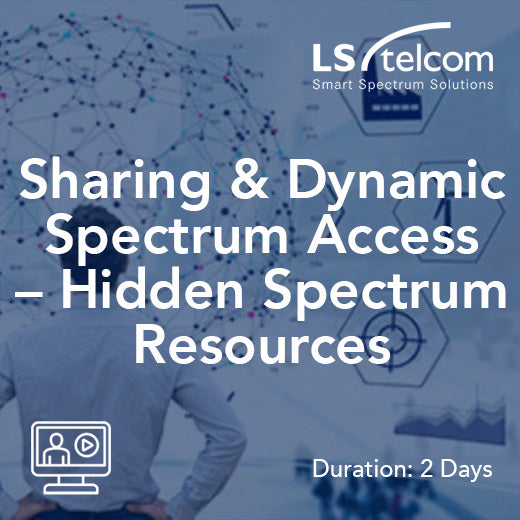
Sharing and Dynamic Spectrum Access – Hidden Spectrum Resources (LS telcom)
The planning rules for radio services often leave small gaps which cannot be used or the scattered use of spectrum by a primary user leaves larger opportunities. Such spectrum might be accessible for different or additional radio services, typically ones with very low power which will not cause undue interference to the primary users. These opportunities were referred to as ‘whitespaces’ but the focus more recently considers methods such as dynamic spectrum assignment. In addition, regulatory techniques are trying to find ways to make sharing spectrum a more common practice for use across a myriad of spectrum services. This course examines the background to whitespaces, considering how and where they arise and looks at a range of sharing opportunities. It then focuses on how spectrum might be made available to additional parties, and what kind of communications it might support. Finally, the various regulatory methods and technologies (including DSA/LSA and the role of databases) being considered will be examined. Course Objectives After completing the course, delegates will understand the history of whitespaces, and the more recent opportunities for sharing together with methods to regulate usage. Current developments and case studies will also be provided. Intended for those who need to understand the regulation and practical application of advanced sharing techniques, whether from a regulatory or commercial perspective. Contents The possible applications for more advanced spectrum sharing methods Technologies being developed for the exploitation spectrum sharing Where are there opportunities for more advanced sharing? How is interference dealt with The regulatory processes and procedures being applied Geographic databases and dynamic spectrum access Licensed shared access and similar regulatory tools About LS telcom: LS telcom is a global leader in technologies and consulting services for efficient radio spectrum use, optimizing spectrum management to ensure reliable, interference-free, and secure radio services. Our portfolio includes consulting, measurement services, and integrated solutions for planning, analysis, monitoring, and managing radio infrastructure. Serving customers in over 100 countries, including regulatory authorities, network operators, and industries such as transport, utilities, and security, LS telcom operates globally with subsidiaries and offices in locations like Germany, the UK, Canada, India, and the UAE. Headquartered in Lichtenau, Germany, LS telcom AG has been listed on the German Stock Exchange since 2001 (ISIN DE 0005754402).
£1,300.00
-
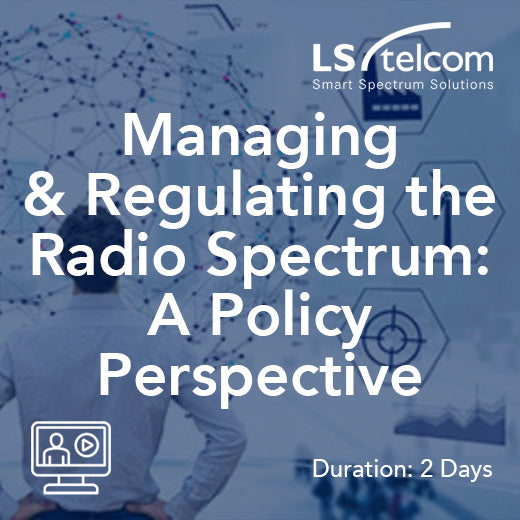
Managing and Regulating the Radio Spectrum: A Policy Perspective (LS telcom)
The radio spectrum is a limited resource that has to be shared between different services, technologies, users and countries. It is the task of regulatory authorities to manage the resource and to optimize its use. International frameworks provide the basis for spectrum management, however knowledge of the characteristics of the radio spectrum and technologies that use it are necessary for these frameworks to be translated into realizable policies and practices at a national and regional level. This course provides an overview of the goals of spectrum management as well as delivering an understanding of the specific characteristics of different parts of the radio spectrum and how this impacts its utility and value. The use of different spectrum bands is discussed, together with a consideration of the way in which historic and new radio technologies use spectrum and the techniques being considered to maximize efficiency and sharing. Different facets of spectrum management and regulation are explained. The course explores assignment and planning methods from the classical command and control techniques to developments in economic techniques such as pricing, trading and auctions. It takes a look at techniques such as spectrum sharing and dynamic access and licensed shared access to help understand what failings of existing techniques they are seeking to redress. Course Objectives After completion of the course, participants will understand how the radio spectrum is used, and approaches to its management and regulation with respect to setting certain policies. They will have extended their knowledge of spectrum management and will have been updated on the latest techniques and processes being employed. Intended for This course is ideal for those working in a policy development and technical/non-technical positions within a spectrum regulator or regulatory body. It is useful for those who wish to deepen their knowledge of the toolkit for spectrum regulation and management including consultants, investors, manufacturers, major spectrum users and those for whom managing the spectrum is a part of their daily job. Contents Characteristics of radio spectrum and radio technologies The international framework and processes for spectrum management Translating spectrum characteristics into policy levers Evolution of spectrum assignment approaches Spectrum sharing; a paradigm to innovative spectrum management About LS telcom: LS telcom is a global leader in technologies and consulting services for efficient radio spectrum use, optimizing spectrum management to ensure reliable, interference-free, and secure radio services. Our portfolio includes consulting, measurement services, and integrated solutions for planning, analysis, monitoring, and managing radio infrastructure. Serving customers in over 100 countries, including regulatory authorities, network operators, and industries such as transport, utilities, and security, LS telcom operates globally with subsidiaries and offices in locations like Germany, the UK, Canada, India, and the UAE. Headquartered in Lichtenau, Germany, LS telcom AG has been listed on the German Stock Exchange since 2001 (ISIN DE 0005754402).
£1,300.00
-
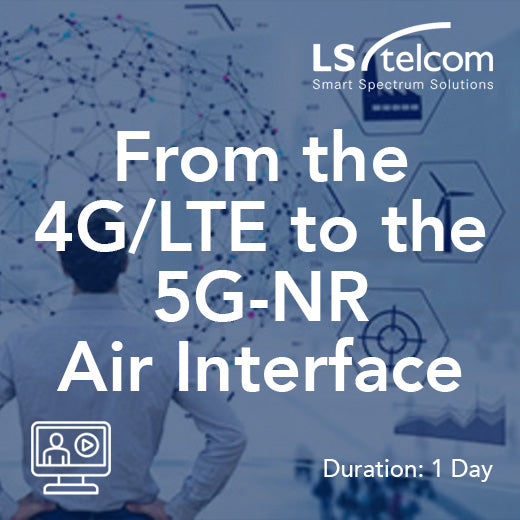
From the 4G/LTE to the 5G-NR Air Interface (LS telcom)
This training course is aimed at those people working within the wireless communication business or broadcast business. Participants will get an overview on the 4G/LTE and 5G-NR physical layer. First of all wireless communication basics like OFDMA, DFTs-OFDMA, Forward Error Correction and MIMO will be discussed followed by an in-depth overview of 4G and 5G technology and standards. The training is presented in cooperation with Rohde & Schwarz. Course Objectives After completing this course, delegates will understand the technology behind 4G and 5G. Focus is on the physical layer not on the protocol level. Several practical demonstrations will solidify the theoretical knowledge. Intended for This course is intended for those who have a basic knowledge in information technology, who may be employed in network operators or regulators. Contents Wireless Communication Basics 4G/LTE Standard 5G Standard About LS telcom: LS telcom is a global leader in technologies and consulting services for efficient radio spectrum use, optimizing spectrum management to ensure reliable, interference-free, and secure radio services. Our portfolio includes consulting, measurement services, and integrated solutions for planning, analysis, monitoring, and managing radio infrastructure. Serving customers in over 100 countries, including regulatory authorities, network operators, and industries such as transport, utilities, and security, LS telcom operates globally with subsidiaries and offices in locations like Germany, the UK, Canada, India, and the UAE. Headquartered in Lichtenau, Germany, LS telcom AG has been listed on the German Stock Exchange since 2001 (ISIN DE 0005754402).
£2,240.00
-

Wireless Connectivity for the Internet of Things (IoT) (LS telcom)
The Internet of Things (IoT) covers a huge range of use cases and applications and scales from single devices to massive systems with various elements connecting in real time. Wireless connectivity is an integral part of IoT. Depending on the application, factors such as range, data requirements, security, power requirements and battery life will dictate the choice of one or some form of combination of wireless technologies. Traditional cellular mobile networks based on 2G/3G/4G have almost ubiquitous coverage and high data rates but at cost of high power requirements at end user devices. Low Power Wide Area Networks (LPWAN) based on standards like LoRaWAN, Ultra Narrow Band (UNB) or NB-IoT, are expected to complement traditional connectivity solutions for long range communication. Short range technologies such as Bluetooth, BLE, ZigBee, WiFi or RFID will provide connectivity over short distances. And, of course, 5G presents another set of opportunities for IoT connectivity. This course explores radio technologies for IoT applications; discusses the underlying concepts and the resulting advantages and limitations. An analysis of spectrum requirements and availability complements the training. Course Objectives After completing the training, participants will be familiar with most recent radio technologies available to power IoT applications. They will understand the differences between the technologies, and the benefits and compromises of each. Intended for This course is intended for those who have basic knowledge in radio communication systems, who are interested in wireless systems for IoT applications and who may be responsible for implementing radio systems in industry. Contents IoT applications and communication requirements Overview on wireless technologies and approaches for IoT applications Spectrum requirements and availability Radio systems for Low Power Wide Area Networks Radio systems for Low Power Personal Area Networks 3GPP systems and the role of 5G for IoT About LS telcom: LS telcom is a global leader in technologies and consulting services for efficient radio spectrum use, optimizing spectrum management to ensure reliable, interference-free, and secure radio services. Our portfolio includes consulting, measurement services, and integrated solutions for planning, analysis, monitoring, and managing radio infrastructure. Serving customers in over 100 countries, including regulatory authorities, network operators, and industries such as transport, utilities, and security, LS telcom operates globally with subsidiaries and offices in locations like Germany, the UK, Canada, India, and the UAE. Headquartered in Lichtenau, Germany, LS telcom AG has been listed on the German Stock Exchange since 2001 (ISIN DE 0005754402).
£690.00
-

Evolution of Cellular Network Deployment (LS telcom)
5G is now widely deployed across the world initially using the non-standalone configuration, meaning the traffic is being carried over the 5G radio network, but it is passed on to a 4G evolved packet core network. Operators are migrating to a standalone configuration and this evolution will have an impact on the range of features that can be offered to users. One of the main features of 5G is enhanced mobile broadband, but in standalone mode enhancements will instantly become available such as industrial automation, network slicing and much lower latency. This course not only examines the regulatory, operational and commercial challenges of 5G networks migrating from non-standalone to standalone, but also provides a detailed view of how operators have deployed 5G within the range of different spectrum bands and configurations. It explores how improvements can be made as network technologies evolve. It provides examples and exercises which untangle these challenges of 5G network deployment for all the parties involved, and it will enable informed business decisions, and help those involved in 5G to continually benefit from future use and roll-out strategies. Course Objectives After completing the course, participants will have a solid grounding in the challenges facing 5G network roll-out and deployment across a range of different scenarios, and will understand the challenges and benefits compared to historical wireless technologies. Intended for Those who wish to strengthen their knowledge of 5G technology, or will be involved in deployment, roll-out or use, and who need to understand the challenges and implications of 5G roll-out on their businesses or organizations. This includes governments, local authorities, vertical industries (e.g. energy, transport, education,healthcare, manufacturing or utilities), operators and vendors. Contents Understand the complexities of 5G roll out and the roadmap over longer-term deployment Identify the key challenges in deploying 5G infrastructure and evolutions towards new features in Standalone mode Examine the likely upgrade costs moving from Non-Standalone to About LS telcom: LS telcom is a global leader in technologies and consulting services for efficient radio spectrum use, optimizing spectrum management to ensure reliable, interference-free, and secure radio services. Our portfolio includes consulting, measurement services, and integrated solutions for planning, analysis, monitoring, and managing radio infrastructure. Serving customers in over 100 countries, including regulatory authorities, network operators, and industries such as transport, utilities, and security, LS telcom operates globally with subsidiaries and offices in locations like Germany, the UK, Canada, India, and the UAE. Headquartered in Lichtenau, Germany, LS telcom AG has been listed on the German Stock Exchange since 2001 (ISIN DE 0005754402).
£690.00
-
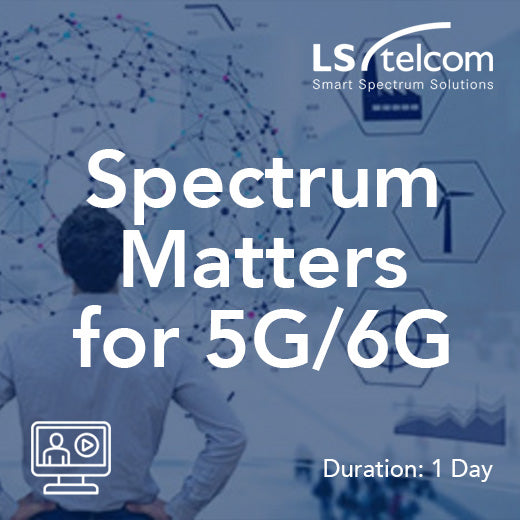
Spectrum Matters for 5G/6G (LS telcom)
5G is driven both by the need for mobile operators to continuously strive to satisfy the growing and unquestionable demand for mobile data, and to support new use cases and services. Regulators and governments have been involved in establishing policies and approaches to award spectrum, so that new 5G services can be rolled out to consumers, enterprises, public sector and government agencies alike. Questions remain about how much more spectrum is needed for 5G but also for what spectrum is needed for 6G which is due for commercialization in the early 2030’s. When it comes to the question of spectrum however, there are many different views about how growth in data traffic impacts upon demand for radio spectrum. It is also evident that below 6 GHz there is very little spectrum remaining that can be re-farmed for mobile services and much of the focus for new spectrum for future mobile (6G) services is concentrated above 6 GHz. How feasible is it to deliver mobile services at such high frequencies? Are there ways to use existing spectrum more efficiently, or are technologies such as LTE and 5G Advanced already very close to the limit of what is achievable? Course Objectives After completing the course, participants will have an understanding of how the evolution towards new standard cellular technologies 5G and 6G has meant identifying new spectrum, or at least one new band. Participants will also understand the practical utilization of ever increasing frequencies in a mobile environment, and whether 6G might mark the end to the hunger of mobile operators for more spectrum. Intended for Those who need to better understand the spectrum implications of 5G and 6G technologies, whether from a regulatory, commercial or technical perspective. Contents Forecasts of demand for data services Realistically forecasting spectrum demand Bands capabilities and issues with existing IMT bands New bands being considered for 5G and 6G services Propagation and coverage of bands above 6 GHz The spectrum efficiency of existing IMT technologies The 5G ecosystem A roadmap for the evolution of 5G services towards 6G Authorization of mobile spectrum About LS telcom: LS telcom is a global leader in technologies and consulting services for efficient radio spectrum use, optimizing spectrum management to ensure reliable, interference-free, and secure radio services. Our portfolio includes consulting, measurement services, and integrated solutions for planning, analysis, monitoring, and managing radio infrastructure. Serving customers in over 100 countries, including regulatory authorities, network operators, and industries such as transport, utilities, and security, LS telcom operates globally with subsidiaries and offices in locations like Germany, the UK, Canada, India, and the UAE. Headquartered in Lichtenau, Germany, LS telcom AG has been listed on the German Stock Exchange since 2001 (ISIN DE 0005754402).
£1,300.00
-
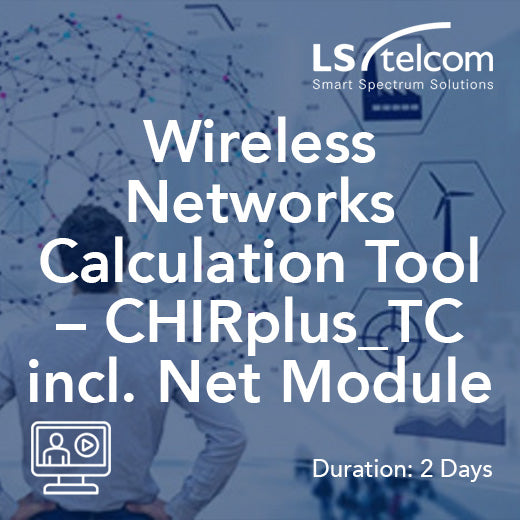
Wireless Networks Calculation Tool – CHIRplus_TC incl. Net Module (LS telcom)
The design of wireless networks considering mobile technologies such as mobile, TETRA, DMR, PMR or wireless IoT (Internet of Things) technologies (e.g. LoRaTM) requires complex calculations to dimension link capacity and link availability and to perform frequency assignment. Planning software like LS telcom’s CHIRplus_TC provides the required functionality in a user-friendly way and are essential for proper network design. A thorough knowledge of the available functionality and understanding of calculation results considerable shortens planning time and results in optimized network performance. The seminar introduces essential features to perform planning tasks for wireless networks systems. The first day is dedicated to the general tool handling. The different database functions and configurations are presented and discussed with the delegates. The following day will cover the necessary steps to perform typical wireless network calculations - from data input over the setting of required parameters to the calculationsanalyses. Finally, reports and data export options will be presented. An overview of the network technologies included in the Net Module will be introduced. The course is presented as classroom training with tool-based exercises to be done by the delegates. After a very short introduction with a few theory slides, the seminar will mostly focus on the topics by corresponding examples shown by the trainer and following dedicated exercises that are carried out by the delegates. Course Objectives After the training the delegates will be able to efficiently perform advanced network design and planning tasks using CHIRplus_TC. They will learn how to get best use on well-established engineering procedures and algorithms for wireless networks. Intended for This course is intended for those who have a basic knowledge in radio communication, who are interested in the functionality provided by CHIRplus_TC and who may be employed in telecoms regulators, telecoms operators, and utility and transportation companies. Contents Setup and configuration of CHIRplus_TC Interaction with the Graphical User Interface (GUI) Usage of databases and spreadsheets (especially filtering) Path profile and line of sight Net Module: Overview of network technologies Standardized data import and export Reports and documentation About LS telcom: LS telcom is a global leader in technologies and consulting services for efficient radio spectrum use, optimizing spectrum management to ensure reliable, interference-free, and secure radio services. Our portfolio includes consulting, measurement services, and integrated solutions for planning, analysis, monitoring, and managing radio infrastructure. Serving customers in over 100 countries, including regulatory authorities, network operators, and industries such as transport, utilities, and security, LS telcom operates globally with subsidiaries and offices in locations like Germany, the UK, Canada, India, and the UAE. Headquartered in Lichtenau, Germany, LS telcom AG has been listed on the German Stock Exchange since 2001 (ISIN DE 0005754402).
£1,300.00
-

Wireless Systems for Industrial Applications – Industry 4.0 (LS telcom)
In nearly every factory floor and industrial setting, communication links are used to carry vital information between machinery and to control and monitor devices. From periodic updates to ongoing process and manufacturing management timely delivery without failure is critical to operations. Cabled systems can be very expensive and tether equipment to fixed locations, reducing flexibility in equipment placement and reorganization. Turning to wireless technology addresses the cabling drawbacks butrequires careful examination of transmission, operational and propagation characteristics to achieve the required performance. A solid understanding of the possibilities and limitations of current radio technologies (including 5G), deployment scenarios and spectrum availability is therefore essential for the successful introduction of wireless systems for automation. This course describes technologies and concepts for wireless communication for industrial applications. It considers the operational requirements, specific RF propagation characteristics, available frequency bands, compatibility issues and develops appropriate design strategies. An overview and comparison of appropriate wireless technologies for industrial applications will complete the training. Course Objectives After completing the course, delegates will understand the requirements and limitations of radio systems for industrial applications. They will know the physical and regulatory constraints of the radio environment and understand the procedures for system planning. Intended for This course is intended for those who have basic knowledge in radio communication systems, who are interested in wireless systems for industrial applications and who may be responsible for radio systems in industry. Contents Introduction: the wireless landscape Industrial requirements Spectrum for wireless automation Radio propagation in industrial environment Wireless network system design criteria and system selection Radio systems for wireless automation Compatibility issues About LS telcom: LS telcom is a global leader in technologies and consulting services for efficient radio spectrum use, optimizing spectrum management to ensure reliable, interference-free, and secure radio services. Our portfolio includes consulting, measurement services, and integrated solutions for planning, analysis, monitoring, and managing radio infrastructure. Serving customers in over 100 countries, including regulatory authorities, network operators, and industries such as transport, utilities, and security, LS telcom operates globally with subsidiaries and offices in locations like Germany, the UK, Canada, India, and the UAE. Headquartered in Lichtenau, Germany, LS telcom AG has been listed on the German Stock Exchange since 2001 (ISIN DE 0005754402).
£690.00
-

Radio Link Calculation and Coordination Tool – CHIRplus_TC (LS telcom)
The design of microwave links requires complex calculations to dimension link capacity and availability or to assign frequencies. The planning tool CHIRplus_TC provides the required functionality in a user-friendly way and is essential for proper link design. The seminar introduces essential features to perform link engineering and planning tasks for Point-to-Point and Point-to-Multipoint systems. The first day is dedicated to the general tool handling. The different database functions and configurations are presented and discussed with the delegates. The following days will cover the necessary steps to perform typical link calculations - from data input over the setting of required parameters to the calculations analyses. Finally, reports and data export options will be presented. The entire workflow that is required to execute microwave radio link planning tasks as well as the Point-to-Multipoint network planning process is covered. Additionally, an overview of further network technologies included in the Net Module will be introduced. Course Objectives After the training the delegates will be able to efficiently solve link planning and coordination tasks using CHIRplus_TC and to interpret the calculation results for microwave links and Point-to-Multipoint networks. Intended for This course is intended for those who have basic knowledge in radio communication and microwave link design and who are interested in the functionality provided by CHIRplus_TC. Contents Setup and configuration of CHIRplus_TC Interaction with the Graphical User Interface (GUI) Usage of databases and spreadsheets (especially filtering) Point-to-Point microwave link design Path profile and link budget Reliability/availability analyses Frequency planning and network optimization Interference calculation and complete network analyses Point-to-Multipoint network planning Net Module: Overview of network technologies Data import and export, reports and documentation About LS telcom: LS telcom is a global leader in technologies and consulting services for efficient radio spectrum use, optimizing spectrum management to ensure reliable, interference-free, and secure radio services. Our portfolio includes consulting, measurement services, and integrated solutions for planning, analysis, monitoring, and managing radio infrastructure. Serving customers in over 100 countries, including regulatory authorities, network operators, and industries such as transport, utilities, and security, LS telcom operates globally with subsidiaries and offices in locations like Germany, the UK, Canada, India, and the UAE. Headquartered in Lichtenau, Germany, LS telcom AG has been listed on the German Stock Exchange since 2001 (ISIN DE 0005754402).
£1,865.00
-
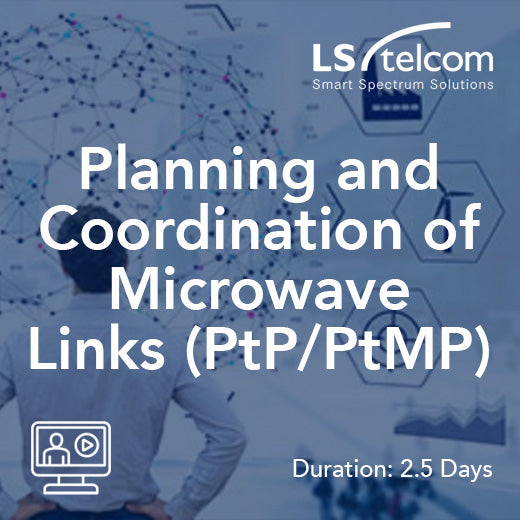
Planning and Coordination of Microwave Links (PtP/PtMP) (LS telcom)
Modern transmission networks require communication links with high link capacity and availability. Microwave Point-to-Point (PtP) and Point-to-Multipoint (PtMP) systems can provide the required performance if the links are designed appropriate. Theoretical know-how combined with best practice for link engineering and design ensures that the possibilities of modern link technology will be fully available after implementation. The course introduces both theoretical and practical knowledge in planning of microwave links. Topics touched cover wave propagation, link budget and availability calculations as well as technical parameters of antennas and microwave devices. Best practice for the analysis of path profiles including line of sight aspects, selection of antenna, modulations scheme and frequency band is provided. Availability engineering of links is discussed as well as frequency and capacity planning for complex transmission networks. This includes the effective use of frequency raster and the analysis of network interference to achieve low interference and high frequency reuse. Course Objectives After completing the course, delegates will be familiar with the principles of microwave radio link planning and will be in the position to design individual microwave links as well as complete PtP and PtMP networks. Intended for This course is intended for those who have basic knowledge in radio communications and microwave link technology, who are interested in microwave link planning and who may be employed in regulators, telecoms operators and utility or transportation companies. Contents Spectrum regulation and licensing aspects Relevant ITU recommendations Wave propagation and effects ITU propagation models Path profile analysis Microwave devices and antennas Availability and error performance Link budget calculation Frequency planning and channel assignment Interference analysis and network optimization About LS telcom: LS telcom is a global leader in technologies and consulting services for efficient radio spectrum use, optimizing spectrum management to ensure reliable, interference-free, and secure radio services. Our portfolio includes consulting, measurement services, and integrated solutions for planning, analysis, monitoring, and managing radio infrastructure. Serving customers in over 100 countries, including regulatory authorities, network operators, and industries such as transport, utilities, and security, LS telcom operates globally with subsidiaries and offices in locations like Germany, the UK, Canada, India, and the UAE. Headquartered in Lichtenau, Germany, LS telcom AG has been listed on the German Stock Exchange since 2001 (ISIN DE 0005754402).
£1,300.00
-
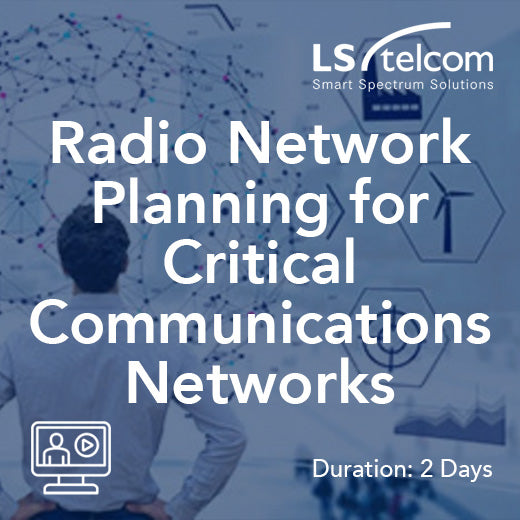
Radio Network Planning for Critical Communications Networks (LS telcom)
Radio networks for professional use in public safety, transportation, utilities, and industry must provide reliable communication for mission critical applications. The use of appropriate design parameter and planning procedures is crucial to achieve the required network performance. This course provides a solid understanding of how to design and plan networks for critical communications using digital radio technologies like TETRA, DMR or LTE/5G. The course follows the typical steps of radio network planning from definition of coverage thresholds, over first network design and coverage planning to the development and analysis of frequency plans. Practical considerations and tasks including site selection and antenna configurations are discussed by means of photos and documents originating from real-life networks. Live calculations with a planning tool are used to illustrate effects of site selection and site and network configuration. Supporting the practical exercises, theoretical elements of the course include the principles of radio propagation, link budgets, the determination of coverage thresholds and capacity considerations. The course will be presented as classroom training with slides, interactive tool calculations and exercises to be done by the participants. Course Objectives After completing the course, delegates will be familiar with the typical procedures for RF network planning for radio technologies like TETRA, DMR and LTE/5G. They know how to define planning criteria for RF networks and understand the underlying technical and theoretical approaches. Intended for This course is intended for those who have basic knowledge in radio network planning, who are interested in radio network planning for critical communications networks and who may be employed in telecoms regulators, telecoms operators, and utility and transportation companies. Contents Targets and procedures for radio network planning System parameter and architecture of critical communication networks Definition of coverage and capacity targets Antenna configurations, site selection and coverage planning Capacity considerations Frequency planning About LS telcom: LS telcom is a global leader in technologies and consulting services for efficient radio spectrum use, optimizing spectrum management to ensure reliable, interference-free, and secure radio services. Our portfolio includes consulting, measurement services, and integrated solutions for planning, analysis, monitoring, and managing radio infrastructure. Serving customers in over 100 countries, including regulatory authorities, network operators, and industries such as transport, utilities, and security, LS telcom operates globally with subsidiaries and offices in locations like Germany, the UK, Canada, India, and the UAE. Headquartered in Lichtenau, Germany, LS telcom AG has been listed on the German Stock Exchange since 2001 (ISIN DE 0005754402).
£1,605.00
-

Radio Networks for Critical Communications (LS telcom)
Professional users in public safety, PPDR, transportation, utilities and industry must rely on efficient radio systems to provide wireless communication for support of their daily operation. Implemented radio technology, network design and user requirements must be carefully matched against each other. A solid understanding of users’ requirements and the possibilities and limitations of technologies is therefore essential. This course discusses issues which need to be considered when a radio system for critical communications shall be introduced or existing systems shall be replaced: Is it better to use services from an existing operator or to build and operate a dedicated network? Which deployment concept should be selected? How to define coverage and capacity? Which technology can provide the required services? These and other questions related to the design and introduction of RF networks for critical communications will be discussed. Starting with specific requirements, the course introduces services specific to critical communications, explains typical planning approaches and highlights possible implementation scenarios. A comparison of recent and upcoming radio technologies like TETRA, DMR, LTE as well as 5G for broadband applications completes the training. Course Objectives After completing the course, delegates will understand users’ requirements and limitations of current radio technologies like TETRA, DMR, LTE, 5G etc. They will know the technical and economic constraints of radio systems for critical communications and will be able to realistically assess the promises of system vendors and service providers. Intended for This course is intended for those who have basic knowledge in radio communication systems, who are interested in technical aspects for critical communications networks and who may be employed in telecoms regulators, organizations for public security and utility and transportation companies. Contents Introduction to radio networks for critical communications Requirements on communication services and applications Mobile broadband for PPDR Elements of a radio network for critical communications Planning and operation of a radio network Radio systems for critical communications (DMR, TETRA, LTE, 5G) About LS telcom: LS telcom is a global leader in technologies and consulting services for efficient radio spectrum use, optimizing spectrum management to ensure reliable, interference-free, and secure radio services. Our portfolio includes consulting, measurement services, and integrated solutions for planning, analysis, monitoring, and managing radio infrastructure. Serving customers in over 100 countries, including regulatory authorities, network operators, and industries such as transport, utilities, and security, LS telcom operates globally with subsidiaries and offices in locations like Germany, the UK, Canada, India, and the UAE. Headquartered in Lichtenau, Germany, LS telcom AG has been listed on the German Stock Exchange since 2001 (ISIN DE 0005754402).
£1,300.00
-

5G Engineering for Railways
This 5G Engineering for Railways course is a technical introduction to 5G. The course includes the design goals and development schedule for 5G, the principles, design and implementation of the 5G air interface, radio access network and core network, and the operation of the 5G system. With the emergence of FRMCS our 5G Rail portfolio addresses the technical requirements of FRMCS. Who would benefit This course is intended for engineers either new to, or already working in, mobile communications. Prerequisites Familiarity with telecommunications and general engineering terminology is assumed. Some understanding of LTE cellular systems would be beneficial. Topic Areas Include 5G introduction, key features and standardisation Use cases and performance objectives Principles of the air interface: radio spectrum, OFDMA and multiple antennas Air interface protocol stack Architecture of the air interface physical layer Procedures for data transmission and reception on the 5G air interface Radio access network architecture and protocols Non-standalone and standalone deployment options Core network architecture and protocols Network function virtualisation and network slicing Interworking and compatibility between 5G, LTE and Wi-Fi PDU connectivity, Quality of Service and service provision Signalling procedures in the 5G network
POA: Private Course





























































